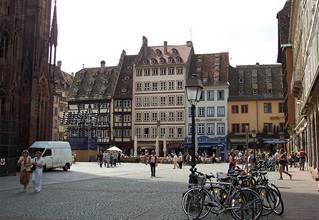We would very much like to do an article on the state of the art of “filtered permeability” for World Streets. If you are strong in this area or have a contact who is, it would be great to hear from you.
Here is how the entry in Wikipedia looked this morning (from a mainly UK perspective):
Filtered permeability
Filtered permeability is the concept, supported by organisations such as Sustrans, that networks for walking and cycling should be more permeable than the road network for motor vehicles. This, it is argued will encourage walking and cycling by giving them a more attractive environment free from traffic and a time and convenience advantage over car driving. Evidence for this view comes from European cities such as Freiburg, and its rail suburb Vauban, and Groningen which have achieved high levels of walking and cycling by following similar principles, sometimes described as: “a coarse grain for cars and a fine grain for cyclists and pedestrians”.[5]
Filtered permeability requires cyclists, pedestrians (and sometimes public transport) to be separated from private motor vehicles in some places, although it can be combined with shared space solutions, elsewhere in the same town or city. This is the case in some Dutch towns such as Drachten.
The principle of filtered permeability was endorsed for the first time in British Government guidance for the eco-towns programme in 2008[6] and later that year by an alliance of 70 organisations concerned with public health, planning and transport in their policy declaration: Take Action on Active Travel.[7]
A parallel debate has been occurring in North America, where researchers have proposed and applied the Fused Grid, an urban street network pattern which follows the principles of filtered permeability, to address perceived shortcomings of both the ‘traditional’ grid and more recent suburban street layouts. A study conducted in Washington State[8] found that the fused grid was associated with significantly higher levels of walking than the other two alternatives. A recent comparison of seven neighbourhood layouts found a 43 and 32 percent increase in walking with respect to a conventional suburban and the traditional grid in a Fused Grid layout, which has greater permeability for pedestrians than for cars due to its inclusion of pedestrian-only paths (filtering). It also showed a 7 to 10 percent range of reduction in driving with respect to the remainder six neighbourhood layouts in the set. [9]
We will be pleased to hear from you.
Eric Britton


Pingback: Groningen, Bicycle Capital of the World « The Gondola Project